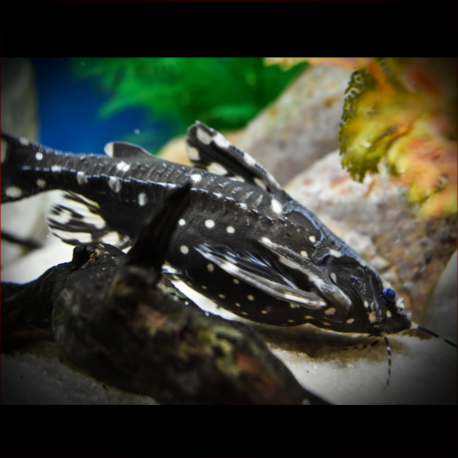More info
Datasheet
| Minimum Tank Size | 115 litres / 30.38 US gallons |
| Maximum Size | 15.0cm / 5.91inches |
| Temperature | 22°C / 71.60°F - 26°C / 78.80°F |
| Hardness | 1.01dgH / 18ppm - 20.00dgH / 357ppm |
| pH | 5.5-7.5 |
General Description
The Spotted Talking Catfish, also known as Agamyxis Pectinifrons, is a hardy and attractive species commonly found in the aquarium trade. Its light body markings can vary in color from white to pale or darkish yellow. Belonging to the Doradidae family within the Siluriformes order, these catfish are distinguished by a unique infranuchal scute and are known for their ability to produce audible sounds, giving them the nickname "talking catfishes."
Aquarium Setup
For optimal care, Agamyxis Pectinifrons should be housed in a dimly-lit aquarium with soft, sandy substrate and ample hiding spots such as aquatic vegetation, driftwood tangles, or artificial caves. Bright lighting should be avoided as these catfish are primarily nocturnal. Water conditions should maintain a temperature of 22-26°C, a pH range of 5.5-7.5, and a hardness of 18-357ppm (see table for tank size requirements and water condition specifics).
Behaviour
Spotted Talking Catfish are non-aggressive but may consume very small fish when adult. They thrive in group settings but can also be kept individually. Displaying gregarious behavior, these catfish are best maintained in groups of 4 or more specimens. They also tend to group together with similar-looking relatives like Platydoras armatulus and Acanthodoras spinosissimus in community tanks.
Feeding and Diet
Agamyxis Pectinifrons are omnivorous and accept a variety of prepared and frozen foods. A balanced diet includes high-quality dried pellets or tablets supplemented with live or frozen foods like bloodworms, Tubifex, and mosquito larvae. Occasional earthworms provide additional protein for their diet.
Reproduction & Dimorphism
There are no known reports of breeding Agamyxis Pectinifrons in captivity without the use of hormones to induce the process. Mature females tend to have a fuller body compared to males, indicating sexual dimorphism in this species.
Habitat and Distribution
Found in various habitat types, Spotted Talking Catfish prefer slow-moving or still waters with abundant submerged or floating structures for hiding during daylight. Indigenous to parts of the Amazon basin in Bolivia, Brazil, Colombia, and Peru, these catfish are commonly encountered in whitewater habitats like the Caño Yarina tributary of the Río Pacaya, known for its diverse aquatic plant species and unique ecosystem.

